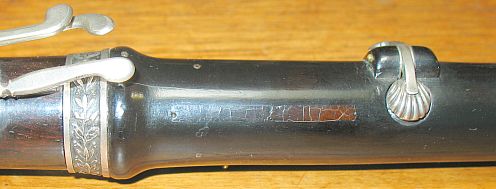
13-key flute by S. Koch, Vienna, c.1825.
The flute below has 13 keys at the present time, but it may have originally had 14.

The missing 14th key would have been, in this case, a long extra lever for D#, similar to the one shown on a much later flute by K. Stecher shown below. The extra D# lever touch is for the LH thumb. The lever pivots on the post-mounted axle in the middle of the photo and vaults over the short F key; its curved end fits under a short 'finger' or extension soldered to the tip of the D# key cup.

I do not know why the extra lever for the D# key on the Koch flute, if there ever was one, was removed later (in the 19th century?). But here is why I think it had one.
Most tellingly, there is a 4 cm long, shallow, slot-shaped indentation in the surface of the Koch, to the left of the short F-key cup, which has been patched with a shellac-like material.

This exactly the place where a wooden block, to guide the shaft and hold the pin for an extra D# lever, would have been. Shown below are the wooden blocks on the opposite side of the Koch, that hold the keys for LH4. They are also 4 cm wide, to support and guide long keys.

The silver lined channels in the blocks go slightly deeper than the level of the main surface of the flute, so that if a block were removed and brought level with the adjacent surface, a shallow groove the thickness of the channel would remain. This is what I think we see.
In the photo below, we can see (though perhaps not very well) that the side of the wooden block holding the D# key is flat and meets the surface of the flute at a 90 degree angle.

This occurs nowhere else on the flute. Otherwise, the sides of the blocks curve and blend into the surface of the flute. The block holding the pin for the lower part of the C# key shows this blending. The D# block may have been cut off sharply to make room for the curved part of an extra D# lever.
There is no evidence at this time of a previous 'finger' on the end of the D# key for the end of an extra D# lever, but a slight abrasion or scratch is visible on the surface of the wood just to the right of the D# key cup. This abrasion could have been wear from the end of an extra D# lever.
If an extra D# lever was ever present on this instrument, it would be a very early appearance of this key.
Thanks to Michael Hubbert for conversations about this flute. Many antique flutes have stories like this to tell about their pasts, when examined closely.